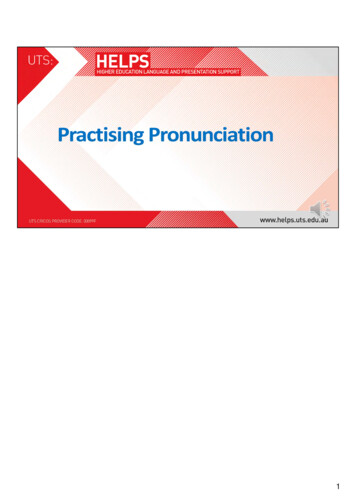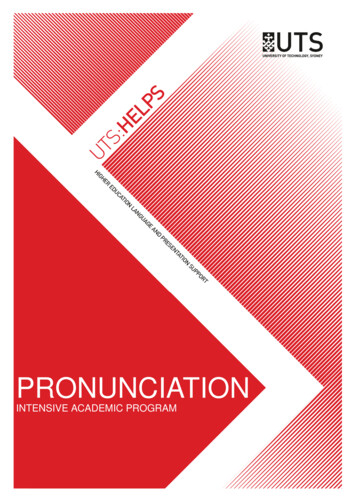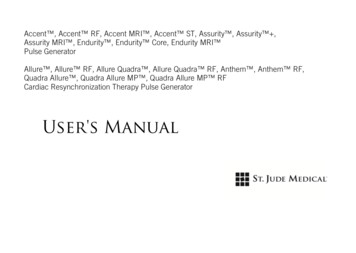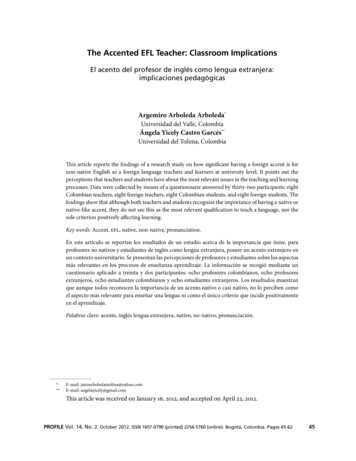
Transcription
!!!!!WORKBOOKBy Sheri Summers and Mark Bevwww.AccentWorkshop.com
Table of ContentsLesson!PageGetting StartedHow to Use this CourseIntroduction5Unit OneIntroduction to the American Accent1What is Accent?62An Overview of the American Accent11Unit TwoBreaking English into Pieces3Meet the Schwa154The American T18Unit ThreeWord Intonation Patterns5Intonation Patterns of 1&2 Syllable Words256Intonation Patterns of 3&4 Syllable Words33Unit FourUnusual Word Intonation7Words that Shift Stress388Missing Syllables41Unit FiveDescriptive Phrases and Compound Nouns9Compound Nouns vs. Descriptive Phrases4410Phrasal Verbs and More48Unit SixLinking Words Together11Linking Words52The American Accent CourseTable of Contents 2009 Accent on SpeakingAll Rights Reserved
Table of ContentsLesson!!!PageUnit SevenContent and Structure Words12Content Words5613Structure Words60Unit EightRhythm and Timing14Rhythm and Timing6415Reducing Modals6716Phrasing70Unit NineSentence Stress17Normal Sentence Stress7318Emphatic and Contrastive Stress76Unit TenAsking Questions19Asking Questions8020Tag Questions85Unit ElevenCompound and Complex Sentences21Sequencing9022Complex Sentences93Unit TwelveClear Speech23Emotion and Mood9524Putting it All Together99The American Accent CourseTable of Contents 2009 Accent on SpeakingAll Rights Reserved
Table of s for Continued Success102Resources104The American Accent CourseTable of Contents 2009 Accent on SpeakingAll Rights Reserved
IntroductionWelcome This is where you’ll find the overview ofCongratulations! You’ve taken the action necessary toimproving not only your pronunciation, but moreimportantly your accent. Be proud of your first actionstep! Now, let’s take the next step together.each lessonNotes:This workbook accompanies the audio portion of theAmerican Accent Course. Each lesson has a presentationof how native speakers produce the language and apractice for you to put your newly attained knowledgeinto valuable, practical everyday use.You may want to print out this workbook and put it in abinder. While it’s not necessary to use a color printer,some of the lessons will benefit from using color ink.(These lessons have a note in the upper, right-hand corner.)Also, notice that each lesson has a right-hand column fornotes, and an overview of each lesson is listed at the topwith a useful quote at the bottom. In the left-handcolumn, you’ll find the visual reenforcement to theaudio lesson; in other words, the important points youneed to help you understand the presentation and helpyou follow along with the practice.Just as important are the suggestions for practice thatyou’ll find at the end of each lesson. We’d like toemphasize the continual need to practice the pointsmade in the lessons.Finally, if you’re not already a member of the AmericanAccent Workshop, we believe!you will find enormousbenefit by joining.! You can sign up atwww.accentworkshop.com.! As a member of this onlinecommunity, you can come to Help Sessions and liveclasses and get real time feedback from expertinstructors. Okay, let’s begin!The American Accent Course“There are some people who livein a dream world, and there aresome who face reality, and thenthere are those who turn oneinto the other.”!!!Douglas EverettIntroduction 2009 Accent on SpeakingAll Rights ReservedPage 5
www.accentworkshop.comAttitudeLesson One AttitudeBefore we begin, you should take a moment to think Spelling and Pronunciationabout your attitudes towards learning an accent in Four Parts of Accent Diagram Intonationanother language. SuggestionsHave you ever asked yourself the following questions?Notes:Is it really possible to change my accent?Is it necessary to change my accent?Will I be giving up a part of who I am by changingthe way I speak?Am I too old?Am I too dumb?Do men/ women pick up on accent better than Ido?Will my native language affect my pronunciation?Can native English speakers understand me?How long is this going to take?Do I really want to do this?Spelling and PronunciationDo NOT be confused by English spelling. It does notalways match the pronunciation. If you have learnedEnglish from books and the written word, it is veryimportant for you to stop thinking about words from theway they are written.English spelling comes from many different places. It isnot consistent!The American Accent Course“There are some people who livein a dream world, and there aresome who face reality, and thenthere are those who turn oneinto the other.”!!!Douglas EverettLesson 1 2009 Accent on SpeakingAll Rights ReservedPage 6
www.accentworkshop.comSpelling and Pronunciation (continued)Lesson One AttitudeJust as an example, take a look at this poem. Although Spelling and Pronunciationmuch of the spelling is the same, the pronunciation is Four Parts of Accent Diagram Intonationcompletely different. SuggestionsYou can hear the poem by nciation/poem01.htmlI take it you already knowOf tough and bough and cough and dough?Others may stumble but not youOn hiccough, thorough, slough and through.Well done! And now you wish perhaps,To learn of less familiar traps?Beware of heard, a dreadful wordThat looks like beard and sounds like bird.And dead, it's said like bed, not beadfor goodness' sake don't call it 'deed'!Watch out for meat and great and threat(they rhyme with suite and straight and debt).A moth is not a moth in mother,Nor both in bother, broth, or brother,And here is not a match for there,Nor dear and fear for bear and pear,And then there's doze and rose and loseJust look them up- and goose and choose,And cork and work and card and wardAnd font and front and word and sword,And do and go and thwart and cartCome, I've hardly made a start!A dreadful language? Man alive!I'd learned to speak it when I was five!And yet to write it, the more I sigh,I'll not learn how 'til the day I die.The American Accent Course“There are some people who livein a dream world, and there aresome who face reality, and thenthere are those who turn oneinto the other.”!!!Douglas EverettLesson 1 2009 Accent on SpeakingAll Rights ReservedPage 7
www.accentworkshop.comFour Parts of AccentLesson One AttitudeVoicing Spelling and Pronunciation Four Parts of AccentVoicing means where your voice comes from.Some languages come from the nose, some comefrom the throat, and some come from the chest. Diagram Intonation SuggestionsNotes:Rhythm and IntonationRhythm and Intonation show the “music” of thelanguage. Every language has its own patterns ofpitch, beat, and speed.Word Connections/LiaisonA liaison is a French word that means connection.All words in a sentence get connected togetherto make it smooth.PronunciationPronunciation (also called articulation) is thesound of the vowels and consonants. They aremade by the placement of the tongue, teeth, lipsand vocal cords.Most important to be understoodNot as important to be understoodThe American Accent Course“There are some people who livein a dream world, and there aresome who face reality, and thenthere are those who turn oneinto the other.”!!!Douglas EverettLesson 1 2009 Accent on SpeakingAll Rights ReservedPage 8
www.accentworkshop.comDiagrams of IntonationLesson One AttitudeSpanish Spelling and Pronunciation Four Parts of Accent Diagram Intonation re are some people who livein a dream world, and there aresome who face reality, and thenthere are those who turn oneinto the other.”!!!Douglas EverettEnglishThe American Accent CourseLesson 1 2009 Accent on SpeakingAll Rights ReservedPage 9
www.accentworkshop.comSuggestions For Practice 1. Watch the videos at www.accentworkshop.com/voicingandfacial.htm and observe how muchAmericans use their jaws and lips to speak. Also payattention to where their voice is coming from.Practice following their speaking styles, first withoutusing words and second while speaking out loud.2. Observe how Americans around you (or on TV ormovies) use their lips, jaws, and air to speak. Recordyour observations in your Awareness Journal.Lesson One Attitude Spelling and Pronunciation Four Parts of Accent Diagram Intonation SuggestionsNotes:3. Find something small (a memento) that you can keepwith you to remind you of your task. It could be apaper clip, a small stone, a ring, or anything that,when you look at it or feel it, you remember that youare working on making changes to the way you speak.4. Practice recording yourself on a computer or digitalrecorder. Concentrate on making sure you really useyour lips and jaw as you speak. Work on bringing yourvoice out on your breath.5. Download a podcast from iTunes (www.itunes.com)or watch a video on YouTube (www.youtube.com) andtry to imitate the speaker. Pay attention to both theintonation and the voicing.“There are some people who livein a dream world, and there aresome who face reality, and thenthere are those who turn oneinto the other.”!!!Douglas EverettThe American Accent CourseLesson 1 2009 Accent on SpeakingAll Rights ReservedPage 10
www.accentworkshop.comLesson TwoStress StressEnglish has 3 (sometimes 4) kinds of stress. The soundsthat you hear go up the most are called Primary Stress.Every content word has one primary stress. (Underlinedsyllables are primary)applevacationelephant Basic Sentence Rhythm and Intonation Emphatic and Contrastive Stress Word Connections Questions Inflection SuggestionsSome words have a Secondary Stress. (Underlinedsyllables are secondary)Notes:donationvacationCaliforniaYou will see the Secondary Stress in compound nouns.bedroomtoothpastebasketballA lot of words have a Weak Stress. The Weak Stress is mostoften a schwa and sometimes a very shortened vowel.annoycalendarAmericaThe 4th stress shows emotion.What?You lost it?No way.Basic Sentence Rhythm and IntonationThere is a major or primary stress in every content word(nouns, verbs, adjectives, and adverbs.)The American Accent Course"Never be bullied into silence.Never allow yourself to be madea victim. Accept no one'sdefinition of your life; defineyourself."!!!Harvey FiersteinLesson 2 2009 Accent on SpeakingAll Rights ReservedPage 11
www.accentworkshop.comBasic Sentence Rhythm and Intonation (cont.)Lesson Two StressThese words often contain secondary and weak stresses Basic Sentence Rhythm and Intonationas well. All other words are usually reduced, or Emphatic and Contrastive Stressweakened. These include prepositions, articles, Word Connections Questionsconjunctions, auxiliary verbs, Be verbs, etc. To weaken Inflectionthem we shorten their vowels or turn them into a schwa Suggestionssound. Because they are short, they sound fast.dog ran to the man.The children received some presents.ANotes:There is a slight difference in stress depending on thepart of speech.nounsverbsadjectivesadverbsThat’s a cake.That’s a big cake.Emphatic and Contrastive StressWe can stress anything, but that highlights it or points itout.That’s a big cake.That’s a big cake.Put it on the table.Put it on the table.We also stress words when we contrast them against oneanother.He likes chocolate ice cream.He likes chocolate ice cream, but she likesvanilla.The American Accent Course"Never be bullied into silence.Never allow yourself to be madea victim. Accept no one'sdefinition of your life; defineyourself."!!!Harvey FiersteinLesson 2 2009 Accent on SpeakingAll Rights ReservedPage 12
www.accentworkshop.comWord ConnectionsLesson Two StressRemember that everything is linked together. Weconnect:consonants with vowelseach other ea chothervowels with vowelsgo away gowawayI ate iyate Basic Sentence Rhythm and Intonation Emphatic and Contrastive Stress Word Connections Questions Inflection SuggestionsNotes:consonants with consonantsgive Johnmusic courseI’d likeshe’s reallyt, d, s, or z with ydon’t you don choodid you di jooguess you gue shoowhere’s your where zhurQuestionsYes/ No questions go up.Do you like it?Is he here?‘Wh’ questions go up and then drop down.Where did she go?How was your class?"Never be bullied into silence.Never allow yourself to be madea victim. Accept no one'sdefinition of your life; defineyourself."!!!Harvey FiersteinInflectionThere’s a boy.There’s a boy in it.The American Accent CourseLesson 2 2009 Accent on SpeakingAll Rights ReservedPage 13
www.accentworkshop.comInflection (continued)Lesson Two StressWhen he opened the door, he saw the basket. Basic Sentence Rhythm and Intonation Emphatic and Contrastive Stress Word Connections QuestionsToday I went to the store, the bank, and the post office. Inflection SuggestionsSuggestions for practice Notes:1. Listen to native English speakers for intonation. Canyou hear the ups and downs of the language? Can youhear the small weak stresses? Write yourobservations in your Awareness Journal.2. Use your memento to help you remember to listenfor intonation in English.3. Find an English speaking actor or actress you admireon TV or a DVD. Imitate their speech, but don’t useany words to do it. Just hum whatever they say. Tryto follow their intonation patterns.4. Try out some of the words and sentences in thislesson, then record them, and listen for the aThe American Accent Course"Never be bullied into silence.Never allow yourself to be madea victim. Accept no one'sdefinition of your life; defineyourself."!!!Harvey FiersteinLesson 2 2009 Accent on SpeakingAll Rights ReservedPage 14
www.accentworkshop.comExamples of the SchwaLesson Three Examples of the SchwaAs mentioned before, the schwa is a very short, very fast Suggestionssound. It can replace any short vowel sound in a weaksyllable. [Repeat after each word.]Notes:(! idaysimplifymilitaryThe American Accent Course“One of the most tragic things Iknow about human nature isthat all of us tend to put offliving. We are all dreaming ofsome magical rose garden overthe horizon--instead of enjoyingthe roses that are bloomingoutside our windows today.”!!!!!!Dale CarnegieLesson 3 2009 Accent on SpeakingAll Rights ReservedPage 15
www.accentworkshop.comExamples of the Schwa (cont.)Lesson Three Examples of the Schwa ��One of the most tragic things Iknow about human nature isthat all of us tend to put offliving. We are all dreaming ofsome magical rose garden overthe horizon--instead of enjoyingthe roses that are bloomingoutside our windows today.”!!!!!!Dale Carnegieth!rfatherotherweatherThe American Accent CourseLesson 3 2009 Accent on SpeakingAll Rights ReservedPage 16
www.accentworkshop.comSuggestions for practice Lesson Three Examples of the Schwa1. Watch the video on Pronouncing the Schwa. You canfind this video under “Watch Pronunciation Videos.”in the Members Only Area of the Home page.2. Listen to native English speakers and see how oftenyou can hear the schwa as they speak. Record yourobservations in your Awareness Journal. SuggestionsNotes:3. Use your memento to focus on listening for theschwa in everyday language.4. Start making a list of words that you use everydaywhich contain schwas. Record them in yourAwareness Journal.5. Practice the following words. Make sure you focuson shortening the vowels that are reduced, orbecome schwas. Then record them and listen for derstandcomputerweather“One of the most tragic things Iknow about human nature isthat all of us tend to put offliving. We are all dreaming ofsome magical rose garden overthe horizon--instead of enjoyingthe roses that are bloomingoutside our windows today.”!!!!!!Dale CarnegieThe American Accent CourseLesson 3 2009 Accent on SpeakingAll Rights ReservedPage 17
www.accentworkshop.comThe American T is different from T's in otherlanguages. If you watched the video, you wouldLesson Four The strong Tnotice that: The “soft” TThe strong T The silent T The “held” T and glottal T Suggestions1. T sounds like /t/ when it is in the beginning of aword, or at the beginning of a primary or secondaryNotes:stressed syllable.1. time2. Tom3. table4. tissue5. terrible6. tongue7. maintain8. Italian9. atomic10. mercantile11. photographer12. TitanicThe “soft” T2. T is softened to nearly a /d/ at the beginning of anunstressed (or weak) syllable.1. cuter2. realityExample:3. greaterwater wader4. heater5. photograph“There are no foreign lands. It isthe traveler only who is foreign.”!Robert Louis Stevenson6. computerThe American Accent CourseLesson 4 2009 Accent on SpeakingAll Rights ReservedPage 18
www.accentworkshop.comThe “soft” T (continued)Lesson Four The strong T7. community The “soft” T8. thirty The “held” T and glottal T The silent T9. water Suggestions10. go tomorrow11. go to the bankNotes:12. at a class13. get out of14. got a tip onThe “held” T and glottal T3. At the end of a word, T is held inside the mouth or issometimes pronounced as a glottal stop.1. thatExample: cat2. white3. yet4. plate5. foot6. treat7. fat8. profit“There are no foreign lands. It isthe traveler only who is foreign.”9. heat10.neat!Robert Louis Stevenson11.exciteThe American Accent CourseLesson 4 2009 Accent on SpeakingAll Rights ReservedPage 19
www.accentworkshop.comThe “held” T and glottal T (continued)Lesson Four The strong T12. delicate The “soft” T13. inherit The “held” T and glottal T The silent T14. adequate Suggestions15. muteThat was good.A white gate.A plate for you.FootballTreat me well.A fat profit for you.Heat the food up.It doesn’t excite me.A delicate child.Inherit some money.Mute button.Notes:4. Words that contain a /t!n/ (unstressed syllable) usea glottal stop or a held T.1. kitten2. buttonExample: kitten3. Martin4. curtain5. mountain6. sentence7. important8. cotton9. fountain10. Hilton11. Clinton“There are no foreign lands. It isthe traveler only who is foreign.”12. eaten13. forgotten!14. BritainRobert Louis Stevenson15. Latin16. certainThe American Accent CourseLesson 4 2009 Accent on SpeakingAll Rights ReservedPage 20
www.accentworkshop.comThe “held” T and glottal T (continued)Lesson Four The strong TWhat a cute kitten.Hit the mute button.Martin Luther KingA white curtainA tall mountain.A long sentence.An important project.A cotton shirt.It’s a beautiful fountain.Hillary ClintonHave you eaten?He’s forgotten.Latin AmericaCertain people like it. The “soft” T The “held” T and glottal T The silent T SuggestionsNotes:5. Words contain “nt” at the end (or "ntly") arepronounced with a sharp stop.1. mount2. pointExample: point3. count4. mint5. can’t6. don’t7. won’t8. saint9. fluent/fluently10. pint11. print12. talent13. accent“There are no foreign lands. It isthe traveler only who is foreign.”14. accident15. treatment!16. significantThe American Accent CourseRobert Louis StevensonLesson 4 2009 Accent on SpeakingAll Rights ReservedPage 21
www.accentworkshop.comThe “held” T and glottal T (continued)Lesson Four The strong T The “soft” T The “held” T and glottal T The silent T17. implant Suggestions18. innocent19. tentNotes:20. silent21. patient/patiently22. aunt23. moment24. current/currentlyThe silent T6. Words with "nt" an unstressed vowel often aren'tspoken with a T sound at all.1. counter2. SacramentoExample: Internet3. pointed4. Santa5. gentleman6. Pontiac7. interview8. international9. printer10. certainty11. accidental“There are no foreign lands. It isthe traveler only who is foreign.”12. rental13. implanted!Robert Louis Stevenson14. enchantedThe American Accent CourseLesson 4 2009 Accent on SpeakingAll Rights ReservedPage 22
www.accentworkshop.comThe T (continued)Lesson Four The strong T7. T in a blend. T is softened when it is after an The “soft” T The “held” T and glottal Tunvoiced consonant. The silent T1. stay Suggestions2. star3. lastedNotes:4. after5. faster6. laughter7. specter8. chapter9. expected8. In some cases, the T disappears when there is aprimary stress “ten.”1. listen2. christen3. soften4. fastenExtra InformationMixed T’stodaypotatotomorrowterminateinto the nightattitudeprotest-teur amateurProtestant-ture naturetreatment-tion nationstatistics-th bath/thingintercontinentalThe American Accent Course“There are no foreign lands. It isthe traveler only who is foreign.”!Robert Louis StevensonLesson 4 2009 Accent on SpeakingAll Rights ReservedPage 23
www.accentworkshop.comSuggestions for practice Lesson Four The strong T1. Figure out how a North American might say thefollowing sentences. Then listen to the homeworkaudio to see if you are right.I don’t know if it's something I want or not.The president of the United States quoted thePrime Minister of Great Britain The “soft” T The “held” T and glottal T The silent T SuggestionsNotes:This time I will try to sell more water heaters inSacramento.The cute little kitten climbed the delicate whitecurtain and accidentally tipped over the tub ofbutter.In recent moments, I wait patiently while lookingat the photo of my aunt whose Pontiac I amabout to inherit.Paris Hilton visited that intercontinental hotelyesterday afternoon and attended a meeting ontime management.2. Practice the sentences as many times as you need tofeel comfortable with them.4. Find a newspaper article and look for all the T’s.Figure out how they should be pronounced andpractice reading the article out loud.5. Pay attention to how native speakers around you usethe T.“There are no foreign lands. It isthe traveler only who is foreign.”!The American Accent CourseRobert Louis StevensonLesson 4 2009 Accent on SpeakingAll Rights ReservedPage 24
www.accentworkshop.comPrinting Note: using a colorprinter will help in this lessonLearning about Intonation PatternsLesson Five Learning about Intonation PatternsIntonation comes from the ups and downs of pitch and Primary Stressstress in a language. In English, a stressed syllable is Secondary Stresslonger, clearer, stronger and often higher in pitch thanan unstressed syllable. Weak Stress Words with 1 Syllable Words with 2 Syllables SuggestionsThere are 3 kinds of stress in English words. We callthem primary stress, secondary stress, and weak stress.In this lesson we will discuss and practice all of them.Notes:Primary StressEvery word has one (and only one) syllable that has aprimary stress.* The primary stress is the strongestsound in the word and it always has a pure vowel sound(never a schwa.) For our purposes, the primary stress isrepresented by a long green bar, like this When the primary stress falls on the last syllable of theword, or the word has only one syllable, it has a falling,or gliding sound. This sound is represented by a greencurve, like this Example: dogHowever, the length of the glide is different dependingon the last sound of the word. If the word ends with anunvoiced sound like /t/ or /k/, the glide will be a littleshorter.*There is an exception which we will talk a lot more about in the future.That is, when we speak at a normal or fast speed we tend to reduce thevowel sounds in what we call structure words. These words include articles,prepositions, conjunctions, pronouns, modals, and often Be verbs.The American Accent Course"A real decision is measured bythe fact that you've taken a newaction. If there's no action, youhaven't truly decided."!!!!Anthony RobbinsLesson 5 2009 Accent on SpeakingAll Rights ReservedPage 25
www.accentworkshop.comPrimary Stress (continued)Lesson Five Learning about Intonation PatternsIf the word ends with a voiced sound like /d/ or /g/, Primary Stressthe glide will be a little longer. And, if the word ends in Secondary Stressa vowel sound, the glide will be even longer.Here are some examples:beatbead Weak Stress Words with 1 Syllable Words with 2 Syllablesbe SuggestionsNotes:Secondary StressSome (but not all) words contain a secondary stress. Asecondary stress isn’t as strong as a primary stress, butlike a primary stress, the vowel sound is pure (not aschwa). For our purposes, the secondary stress isrepresented by a shorter blue bar, like this As you probably guess, a word must have at least two ormore syllables in order to have a secondary stress.Weak StressIf you remember when we talked about the intonationpatterns of English in a previous class, you will recallthat it has a lot of big sounds and a lot of small sounds.The small sounds are due to the weak stress in English.Weak vowels are spoken, but they are very small. It’salmost like we are trying to get from one consonant tothe next without considering the weak vowel much at"A real decision is measured bythe fact that you've taken a newaction. If there's no action, youhaven't truly decided."!!Anthony Robbinsall.The American Accent CourseLesson 5 2009 Accent on SpeakingAll Rights ReservedPage 26
www.accentworkshop.comWeak Stress (continued)Lesson Five Learning about Intonation PatternsMost weak vowels become schwas /!/. For our Primary Stresspurposes, a syllable with a schwa is written as a red Secondary Stress Weak Stressdot, like this Words with 1 Syllable Words with 2 Syllables SuggestionsSometimes weak syllables keep their original sound, butare made very short. The most common weakenedNotes:sounds are /iy/ and /i/. For example,babyEnglishNote: You may also hear weak /o"/’s as in tomato andshort /u"/’s as in tissue.When the syllable is weak, but doesn’t change to aschwa, we will write it as a slightly elongated red oval,like this "A real decision is measured bythe fact that you've taken a newaction. If there's no action, youhaven't truly decided."!The American Accent Course!Anthony RobbinsLesson 5 2009 Accent on SpeakingAll Rights ReservedPage 27
www.accentworkshop.comWords with 1 SyllableEnds with VowelEnds with Voiced Sound1heyseedoflyshoemesaydrawhinoEnds with Unvoiced wifecatbookjuicehopedeskhealthmissThe American Accent CourseLesson 5 2009 Accent on SpeakingAll Rights ReservedPage 28
www.accentworkshop.comWords with 2 SyllablesPrimary WeakWeak neindulgeastoundinsiderefuseupheldbelieveThe American Accent statecompeteadviceLesson 5 2009 Accent on SpeakingAll Rights ReservedPage 29
www.accentworkshop.comSuggestions for practice Lesson Five Learning about Intonation Patterns1. Listen to this word list on “Audio for Homework” andthen put the following words in their correctintonation pattern categories above. (Use your pausebutton if you need to.) Primary Stress Secondary Stress Weak Stress Words with 1 Syllable Words with 2 lanailandlawMalaymassagemilkmillpenquickrat SuggestionsNotes:"A real decision is measured bythe fact that you've taken a newaction. If there's no action, youhaven't truly decided."!The American Accent Course!Anthony RobbinsLesson 5 2009 Accent on SpeakingAll Rights ReservedPage 30
www.accentworkshop.comSuggestions for practice (continued)Lesson Five Learning about Intonation ngteatoe Primary Stress Secondary Stress Weak Stress Words with 1 Syllable Words with 2 Syllables SuggestionsNotes:2. Make a list of your own one and two syllable wordsand put them in the appropriate categories above.Put words that don’t fit into these categories onanother paper.3. Practice repeating the words under each categoryuntil you begin to feel comfortable with them.4. Use your memento to remind yourself to listen to theEnglish around you while trying to figure out thelength of one syllable words and the primary stress atthe end of two syllable words.5. Add one of your own words to each list below. Becareful that you put them under the wayallow"A real decision is measured bythe fact that you've taken a newaction. If there's no action, youhaven't truly decided."!The American Accent Course!Anthony RobbinsLesson 5 2009 Accent on SpeakingAll Rights ReservedPage 31
www.accentworkshop.comSuggestions for practice (continued)Lesson Five Learning about Intonation dmitpronounce Primary Stress Secondary Stress Weak Stress Words with 1 Syllable Words with 2 Syllables SuggestionsNotes:Answers to Assignment #1Ends with VowelEnds with Voiced SoundEnds with Unvoiced ilkquickratPrimary husbandillnessWeak The American Accent CourseattackdirectitselfrejoiceLesson 5 2009 Accent on SpeakingAll Rights ReservedPage 32
www.accentworkshop.comPrinter Note: use colorprinter for this lessonLearning about Intonation PatternsLesson SixLast time we talked about the intonation patterns of one Words with 3 Syllables Learning about Intonation Patternsand two syllable words. In this class we will continue to Words with 4 Syllables Suggestionsdiscover stress patterns by using words with three ormore syllables. [Repeat after each word]Words with 3 manhonestyhosp
The American Accent Course Table of Contents! Getting Started How to Use this Course Introduction 5 Unit One Introduction to the American Accent 1 What is Accent? 6 2 An Overview of the American Accent 11 Unit Two Breaking English File Size: 982KBPage Count: 104Explore furtherAmerican accent training 4th edition pdfdaotaolaixesontay.comAmerican Accent Training Pdf Free - XpCoursewww.xpcourse.com(PDF) Standard American Accent Worksheet pradeep chettry .www.academia.edu(PDF) American Accent Training.pdf Raed Nemri - Academia.eduwww.academia.eduEnglish Accent Training Pdf - XpCoursewww.xpcourse.comRecommended to you b










